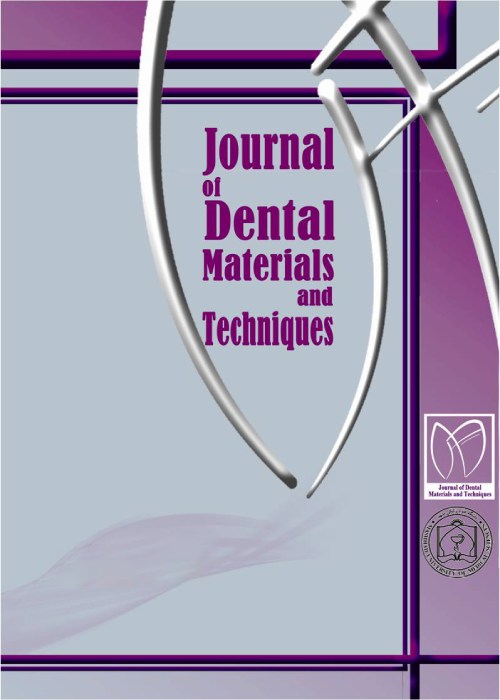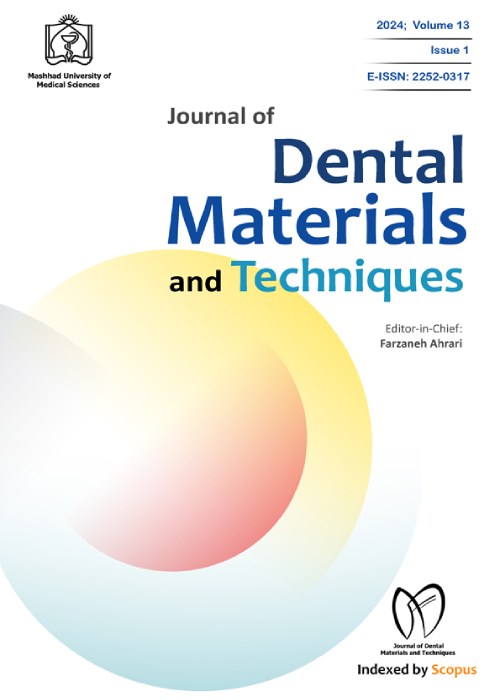فهرست مطالب

Journal of Dental Materials and Techniques
Volume:12 Issue: 1, Winter 2023
- تاریخ انتشار: 1402/02/18
- تعداد عناوین: 8
-
-
Pages 1-9Introduction
Dental sensitivity is one of the most prevalent clinical consequences among patients who receive in-office bleaching therapy. This study aimed to evaluate the effect of adding sodium hexametaphosphate (SHMP) to an in-office bleaching gel on tooth whitening and sensitivity after the treatment.
MethodsThe right and left maxillary lateral incisors of 34 patients were randomly divided into intervention and control groups. In the control side, a bleaching gel containing 37.5% hydrogen peroxide was used, whereas in the intervention side, a combination of the same bleaching gel with 1% SHMP was applied for 30 minutes. Tooth sensitivity to cold, tactile sensitivity, and spontaneous sensitivity was measured before the treatment, and immediately, 24 hours, one week, and one month after therapy. Color changes were measured objectively by a spectrophotometer using the total variation in color (ΔE), and subjectively by a Vita Classical Shade Guide (ΔSGU).
ResultsImmediately after bleaching, cold and tactile sensitivity was higher in the control group compared with the intervention group, but there was no significant difference between groups in any of the sensitivity parameters at different measurement intervals (P>0.05). Spontaneous and tactile sensitivity decreased significantly in both groups over one month (P<0.05). There was no significant difference in ΔE and ΔSGU between the intervention and control groups (P>0.05).
ConclusionThe addition of SHMP to the bleaching gel could not reduce sensitivity to cold, as well as tactile and spontaneous sensitivity; however, it showed no adverse effect on the bleaching effectiveness.
Keywords: Hydrogen peroxide, Sodium hexametaphosphate, Tooth bleaching, Tooth sensitivity, Tooth whitening -
Pages 10-15Introduction
The type of bonding agent and adhesive can play an important role in the bond strength of orthodontic brackets. This study measured and compared the shear bond strength (SBS) of brackets bonded with Z250 and Denu adhesives, as well as two different types of bonding agents (Single Bond and Denu Bond).
MethodsIn this in vitro study, 80 intact premolars were randomly divided into four groups (20 teeth per group). The brackets were bonded to the teeth in the following order: group A: Single Bond + Z250 adhesive; group B: Denu Bond + Z250 adhesive; group C: Single Bond + Denu adhesive; and group D: Denu Bond + Denu adhesive. The SBS values were recorded using a universal testing machine, and Adhesive Remnant Index (ARI) scores were determined. The data were analyzed by ANOVA and Fisher's exact test at a significance level of 0.05.
ResultsThe mean SBS values of the A, B, C, and D groups were reported as 16.66, 17.21, 14.61, and 15.91 MPa, respectively. No significant difference was found among the groups in terms of SBS and ARI scores (P=0.06 and P=0.78, respectively).
ConclusionThe Denu adhesive can be used as a clinical alternative to commercial adhesives, such as Z250, for bonding metal orthodontic brackets. Moreover, bonding agents and adhesives from different companies can be used simultaneously.
Keywords: Composites Resin, Orthodontics, Bond Strength, bonding agent -
Pages 16-21Introduction
Marginal adaptation is important for the long-term success of restorations. The finish line design can influence the marginal integrity. This study aimed to evaluate the effect of radial shoulder and deep chamfer finish line designs on the marginal adaptation of zirconia copings fabricated by the CAD-CAM system.
MethodsIn this experimental study, a standard chrome-cobalt die (height: 7mm, diameter: 5mm) was designed by software. The data were sent to a 3D printer device, and the resin pattern of the standard die was fabricated. After casting the resin pattern, a standard chrome-cobalt die was obtained with a 1-mm radial shoulder finish line and a 0.8-mm deep chamfer finish line. The walls were 12° converge (6° each) towards the occlusal surface. The standard die was replicated 9 times with a polyvinyl siloxane elastomeric material and poured with type IV dental stone. Zirconia copings were fabricated, and the vertical gap at 8 points was measured by a stereo microscope. Data were analyzed by the t-test, and statistical significance was set at α=0.05.
ResultsThe vertical gap values were 102.91 µm for deep chamfer and 82.42 µm for radial shoulder finish lines. There was no significant difference between the two preparation designs in terms of the mean vertical gap (P=0.098).
ConclusionThe results of this study showed clinically acceptable marginal adaptation values for both deep chamfer and radial shoulder preparation designs without a statistically significant difference.
Keywords: CAD-CAM, marginal adaptation, Zirconia -
Pages 22-27Introduction
Cention N is an alkasite restorative material, containing alkaline fillers. It is assumed that Cention N can neutralize an acidic pH by releasing fluoride, calcium, and hydroxyl ions. This study aimed to compare the antibacterial activity of Cention N with conventional glass ionomer cement (GIC) and resin-modified glass ionomer cement (RMGIC).
MethodsTwenty experimental specimens were prepared from each of the Fuji IX (GIC), Fuji II LC (RMGIC), and Cention N (alkasite) using a cylindrical-shaped mold. The specimens were placed in agar plates at 37°C and inoculated with S. mutans (ATCC 25175). After 48 hours, the diameter of growth inhibition zones was recorded for each group at different time intervals including 3, 6, 12, 24, and 48 h. The data were analyzed by one-way ANOVA and Tukey's HSD test with a confidence level of 0.05.
ResultsCention N exhibited significantly higher antimicrobial activity against S. mutans at 3, 6, 24, and 48 h as compared to Fuji IX and Fuji II LC (P<0.05).
ConclusionsCention N could be considered as a suitable alternative for glass ionomers and resin-modified glass ionomers concerning its caries-preventive effects.
Keywords: Alkasite, dental cement, Glass Ionomer, resin-modified glass ionomer, s. mutans -
Pages 28-34Introduction
This study aimed to compare the effectiveness of XP-endo Finisher (XPF), self-adjusting files (SAF), and Canal Brush (CB) systems in removing calcium hydroxide (CH) from an artificial standardized groove (ASG) created in the apical root area.
MethodsFifty-five mandibular premolar teeth were prepared to size Reciproc R40 and were split longitudinally. An ASG was prepared in the apical third of the root and filled with CH. The root halves were reassembled, and the samples were divided into two control groups [positive control and negative control (n=5)] and three experimental groups [XPF, SAF, and CB, (n=15)]. The results were evaluated according to a four-grade scoring system to assess the remained CH in ASGs. The statistical difference between the groups was analyzed using the Kruskal-Wallis test.
ResultsThere was no statistically significant difference between the experimental groups in the ability to remove CH from the apical root thirds (P>0.05).
ConclusionNone of the finishing techniques could completely clean CH. The SAF, XPF, and CB systems showed comparable efficacy in removing CH from the roots.
Keywords: Calcium hydroxide, root canal medicament, Root Canal Therapy -
Pages 35-42Introduction
This study evaluated the effect of central cavitation depth and the presence of ferrule on the mechanical retention of zirconia endo-crowns.
MethodsA mandibular molar was selected and scanned after different preparations. The preparation designs were grouped as follows: Group 1 (Control): Full coverage complete crown, group 2 (EF4): endo-crown with 4 mm central cavity depth and ferrule, group 3 (E4): butt joint endo-crown with 4 mm central cavity depth, group 4 (E2): butt joint endo-crown with 2 mm central cavity depth, and group 5 (EF2): endo-crown with 2 mm central cavity depth and ferrule. Then zirconia copings were made using computer-aided design (CAD) and computer-aided manufacturing (CAM) and cemented by glass ionomer. After thermocycling, the specimens were subjected to a tensile test along the axis and at an angle of 30°.
ResultsAll restorations in E2 were deboned during thermocycling. There was no significant difference between the other groups in pulling-out forces. Pulling-out forces under the axial test were 75.7 N, 84.7 N, 98.7 N, and 80.9 N, and under the lateral force were 21.2 N, 27.5 N, 35.4 N, and 28.5 N, for the control, E4, EF4, and EF2 groups, respectively. The difference in pulling-out forces was not significant between the control, E4, EF4, and EF2 groups (P=0.46).
ConclusionThe presence of ferrule increased mechanical retention to some extent. It appears that peripheral reduction in the aims of gaining a ferrule may increase mechanical retention in teeth with shallow cavity depths.
Keywords: Central cavitation depths, endo-crown, Ferrule, Mechanical retention, Zirconia -
Pages 43-50Introduction
The study aimed to assess the histologic and histomorphometric effects of leukocyte platelet-rich fibrin (L-PRF) and nano-hydroxyapatite (nHA) on the regeneration of calvarial bone defects in rabbits.
MethodsFour defects were created in the calvaria bone of 14 New Zealand rabbits and filled with L-PRF clot, nHA, or a combination of L-PRF and nHA. The fourth defect remained unfilled to serve as the control group. The rabbits were sacrificed either at 4 or at 8 weeks, and the specimens were evaluated for the type and degree of inflammation, foreign body reaction, new bone formation, and residual biomaterial particles.
ResultsThe histomorphometric analysis revealed that L-PRF significantly enhanced osteogenesis (P<0.05), and the number of subsequent remnant bodies in the L-PRF group was not significantly different from the control group (P>0.05). The results of the histologic analysis showed that the frequency of central bone regeneration significantly increased in prolonged periods (P<0.05). There was no significant difference in the utilized biomaterials concerning subsequent bleeding, inflammation, foreign body reaction, and lateral bone regeneration between 4 and 8 weeks of treatment (P>0.05).
ConclusionThe results showed that L-PRF was a suitable option for the induction of bone regeneration with fewer remnant bodies. However, future clinical studies are required to assess the efficacy of these biomaterials in the clinical setting.
Keywords: bone regeneration, leukocyte platelet-rich fibrin, Nano-hydroxyapatite -
Pages 51-54Introduction
Dental implants deserve increasing attention because the number of completely and partially edentulous patients is growing due to the higher life expectancy in most populations. Osseointegration is a crucial factor in the success of dental implants. This study investigated the effect of coating titanium implants with stem cells on the osseointegration of dental implants.
MethodsDatabases of PubMed, Scopus, and Web of Science were searched with defined MeSH and non-MeSH keywords of implant, osseointegration, and stem cell, in the title/abstract and MeSH fields. The related articles were first selected according to the content of the title and abstract, and then the full text was assessed.
ResultsBone marrow mesenchymal stem cells and stem cells from human exfoliated deciduous teeth were shown to be useful in achieving better and accelerated osseointegration.
ConclusionDental implants coated with different stem cells showed encouraging results in osseointegration. These findings will help in achieving better osseointegration of implants in patients with inadequate alveolar ridge volume, or healing impairments. The maxillofacial stem cell niches might be the focus of future research for improving osseointegration.
Keywords: Dental implants, implant surface coating, osseointegration, Stem cells


